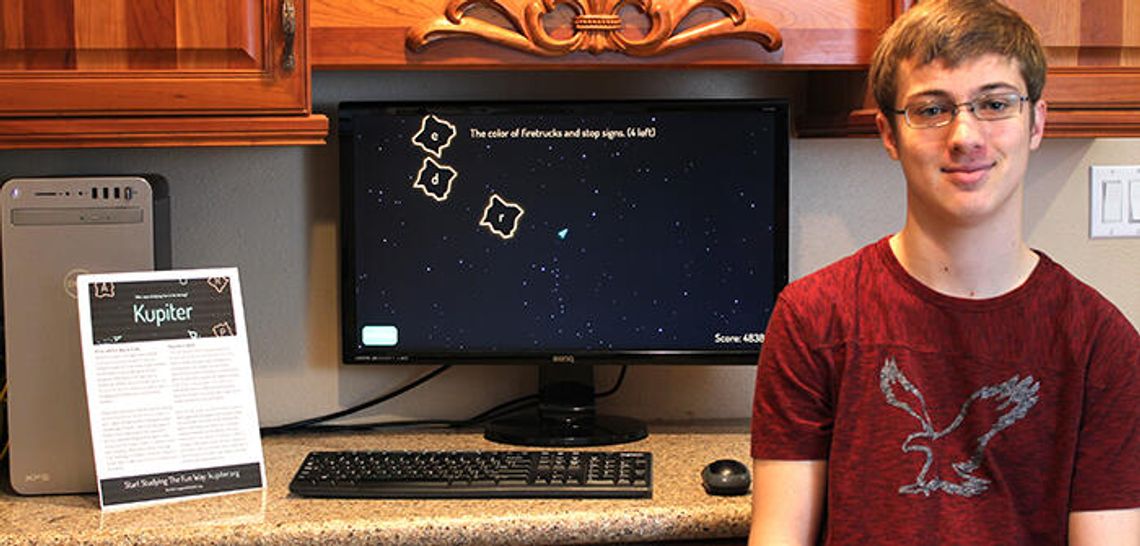In a world filled with new technology and limitless knowledge at one’s disposal, classrooms in Hays Consolidated look to fellow students at ways to develop educational growth in this digital age.
Coding classes are now offered at most public schools as a language credit, and access to the internet and limitless communication across the planet has developed a new way of learning.
For Kevin Champagne, student at Hays High, coding is more than just another language to read. It’s also an opportunity to expand educational growth and development.
That’s why Champagne created Kupiter, a space themed study video game, for the purpose of enhancing students’ abilities to learn with additional resources.
How the game works is a teacher or student will load a question set into the game’s database.
These questions could range from vocabulary, multiple choice, spelling and foreign language. The player will then be prompted into the game, where the player guides a spaceship in an asteroid field.
The asteroids will contain answers to a question listed at the top of the screen. The player will need to shoot the correct asteroid before moving on to the next question.
Kupiter has real-time leaderboards and students can import questions from Quizlet, a popular flash card and studying website, into the game’s question sets.
“A huge process of creating my game was showing it to friends to provide feedback,” Champagne said. “I made sure I would talk to non-gamers and gamers alike to get a diverse look at my game.”
Champagne said the process has taught him to listen to his peers’ concerns or likings, which helped formulate the direction he wanted to take the game.
Features have been added over time to give Kupiter a fresh way to play the game at every revision.
To make the game more challenging, Champagne added a feature where enemies will spawn at an incorrect answer.
This feature in particular came in light of public feedback from his peers, who wanted the game to punish players for being wrong.
“A lot of educational games are just animated quizzes and aren’t really effective or fun to play,” Champagne said. “Kupiter is unique because it combines these elements of fun and learning into one idea.”
Maria Brown, Spanish teacher at Hays High, has integrated Kupiter into her curriculum as an additional study resource for her students.
Brown shares the link to the game via Google Classroom, which the students can access through any device, including mobile devices.
“It’s a great resource for foreign languages and it’s an easy way for me to create vocabulary practice for my students,” Brown said. “I upload my questions from Quizlet into the game. It’s that easy.”
For students who prefer visual ways of learning, Kupiter is a great resource, Brown said. Some of her students prefer traditional methods while others find Kupiter’s user interface a great method for learning.
Development
Kupiter’s development included a business model that helped Champagne market and sell his game.
Before writing a single line of code, Champagne compiled concept art and ideas that projected the philosophy and aesthetics he wanted his project to include.
Everything from the website to the game itself follows a similar color pallet and “space theme.”
The game itself is coded using a text editor in Hypertext Markup Language (HTML) 5 and Java Script and is running on the Phaser graphics engine, all of which are hosted on the site.
The name, Kupiter, has its origin in the Kuiper Belt, an asteroid belt beyond the orbit of Neptune, which is believed to contain small and large bodies or ice and rock.
Champagne said “Kupiter” sounded like something that belonged in space, and the name stuck.
“Kupiter is a business as much as it is a game,” Champagne said. “It’s been a good opportunity for me and it’s something I want to explore when I’m older.”
Champagne said he wants to pursue a career in computer science and business when he goes to college. With over seven years of coding under his belt and marketing experience from Kupiter, Champagne is on track for his career years before college.
“He’s a very humble kid and he cares about his work. It’s awesome to see how much he’s done,” Brown said. “It’s nice to see how much the game has grown and how much he listens to that feedback from his peers.”











